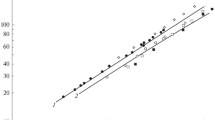Abstract
The results from an experimental investigation of two-phase flow motion through a submerged perforated sheet (SPS) obtained at the Elektrogorsk Research Center test facility are presented. The test facility, the test section of which is a transverse “cutout” from the full-scale PGV-1000 steam generator with the models of vessel internals, is described in detail. The procedure for carrying out trial startups is outlined, and the system of instrument and control devices is described. The SPS used in all experimental modes of operation had the perforation ratio (the hole area to the sheet area ratio) equal to 5.7%. The pressure in the system was around 7 MPa, and the flow rate of supplied steam was varied from 4.23 to 7.94 t/h, which corresponded to the steam velocity at the evaporation surface equal to 0.15–0.29 m/s. Distributions of pressure difference across the SPS and void fractions under the SPS and above it are obtained. The SPS hydraulic friction factor for a two-phase flow is determined as a result of processing the experimental data. A correction for two-phase nature of the flow for the SPS operating conditions is determined by comparing the obtained SPS hydraulic friction factor for a two-phase flow with the SPS hydraulic friction factor to single-phase flow of steam. It is shown that this correction can be either greater than unity (at low void fractions) or less than unity (at high void fractions).
Similar content being viewed by others
References
A. G. Ageev, V. B. Karasev, I. T. Serov, and V. F. Titov, Separation Devices at Nuclear Power Plants (Energoizdat, Moscow, 1982) [in Russian].
N. G. Rassokhin, Steam Generating Installations at Nuclear Power Plants (Energoatomizdat, Moscow, 1987) [in Russian].
N. B. Trunov, S. A. Logvinov, and Yu. G. Dragunov, Hydrodynamic and Thermochemical Processes in the Steam Generators of VVER-Based Nuclear Power Plants (Energoatomizdat, Moscow, 2001) [in Russian].
A. M. Kutepov, L. S. Sterman, and N. G. Styushin, Hydrodynamics and Heat Transfer during Vaporization (Vysshaya Shkola, Moscow, 1986) [in Russian].
V. Melikhov, O. Melikhov, Yu. Parfenov, and A. Nerovnov, “Simulation of the thermal hydraulic processes in the horizontal steam generator with the use of the different interfacial friction correlations,” Sci. Technol. Nucl. Install., No. 5 (2011), Article ID 181393, DOI: 10.1155/2011/181393.
A. A. Nerovnov, Yu. V. Parfenov, V. I. Melikhov, and O. I. Melikhov, “A comparative analysis of the calculation expressions for a two-velocity model describing two-phase flow of steam-water mixture across a tube bundle,” Therm. Eng. 59(9), 726 (2012).
V. I. Melikhov, O. I. Melikhov, and A. A. Nerovnov, “The influence of interphase hydraulic friction models on the calculations of steam-water mixture flow in a steam generator,” Vestnik MEI, No. 1, 43–48 (2012).
V. G. Asmolov, V. N. Blinkov, V. I. Melikhov, O. I. Melikhov, A. A. Nerovnov, and Yu. V. Parfenov, “Comparison of two approaches for calculating the force interaction between a two-phase flow and a tube bundle,” Izv. Vyssh. Uchebn. Zaved., Yadern. Energ., No. 3, 3–8 (2012).
E. Yanssen, “Pressure loss in a two-phase steam-water flow moving through abrupt constrictions and expansions in the pressure range 42–98 atm,” in Advances in the Field of Heat Transfer, Ed. by V. M. Borishanskii (Mir, Moscow, 1970), pp. 147–169 [in Russian].
G. I. Barenblatt, Similarity, Self-Similarity, and Intermediate Asymptotics: Theory and Applications for Geophysical Hydrodynamics (Gidrometeoizdat, Leningrad, 1982) [in Russian].
S. S. Kutateladze and M. A. Styrikovich, Hydrodynamics of Gas-Liquid Systems (Energiya, Moscow, 1976) [in Russian].
I. S. Dubrovskii and A. G. Ageev, “Hydrodynamics of submerged perforated boards,” Therm. Eng. 21(8) (1974).
G. A. Ryabov and Yu. V. Kozlov, “An experimental investigation into the hydrodynamics of submerged perforated sheets,” Therm. Eng. 31(8) (1984).
G. A. Ryabov, V. B. Karasev, and Yu. V. Kozlov, “An experimental investigation of the hydraulic friction of perforated sheets on a steam-water mixture,” Therm. Eng. 31(6) (1984).
R. V. Vasil’eva, I. S. Dubrovskii, A. G. Ageev, V. B. Karasev, E. V. Sakovich, and V. D. Bainyakshin, “Hydrodynamics of the submerged perforated boards used in the steam generators at nuclear power plants,” Elektr. Stn., No. 8, 12–15 (1986).
A. G. Ageev, R. V. Vasil’eva, A. I. Dmitriev, G. A. Tarankov, and V. F. Titov, “Investigation of the hydrodynamics in a PGV-1000 steam generator,” Elektr. Stn., No. 6, 19–23 (1987).
E. P. Svistunov and G. A. Tarankov, “The effect the submerged perforated sheet design has on steam distribution,” Energomashinostr., No. 1, 15–19 (1987).
E. S. Saakov, E. P. Svistunov, V. Yu. Pikus, A. V. Nekrasov, V. P. Sevast’yanov, V. L. Mukhachev, G. A. Tarankov, and V. P. Molchanov, “Investigating the equalizing ability of the submerged perforated sheet in a PGV-1000 steam generator,” Therm. Eng. 39(7) (1992).
N. B. Trunov, V. V. Sotskov, A. G. Ageev, and R. V. Vasil’eva, “Calculated substantiation of the separation arrangement used in a PGV-1500 steam generator,” VANT, Ser. Obesp. Bezop. AES, Issue 13, 43–50 (2006).
A. G. Ageev, R. V. Vasil’eva, I. V. Elkin, V. I. Melikhov, O. I. Melikhov, S. M. Nikonov, Yu. V. Parfenov, A. A. Nerovnov, and A. V. Troshin, “Validating the STEG computer code against experimental data,” in Proceedings of the 8th International Workshop on Horizontal Steam Generators, OKB Gidropress, Podolsk, May 19–21, 2010, Electronic data 2010, CD-ROM No. sgpg2010–047.
Author information
Authors and Affiliations
Corresponding author
Additional information
Original Russian Text © V.N. Blinkov, I.V. Elkin, D.A. Emelianov, V.I. Melikhov, O.I. Melikhov, A.A. Nerovnov, S.M. Nikonov, Yu.V. Parfenov, 2015, published in Teploenergetika.
Rights and permissions
About this article
Cite this article
Blinkov, V.N., Elkin, I.V., Emelianov, D.A. et al. The influence of void fraction on the submerged perforated sheet hydraulic friction factor. Therm. Eng. 62, 484–489 (2015). https://doi.org/10.1134/S0040601515070010
Published:
Issue Date:
DOI: https://doi.org/10.1134/S0040601515070010



